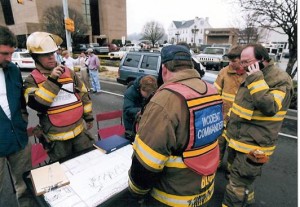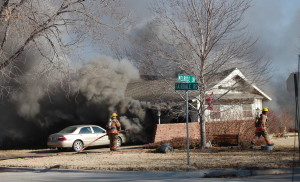By: Robert Avsec, Executive Fire Officer
One of my post-Fire & EMS career “gigs” involved reviewing firefighting videos from across the Internet as selected  by my editor at FireRescue1.com, Rick Markley and creating a training guide for each video that firefighters and officers can use to learn from the actions of others. To date, I’ve reviewed dozens of such videos, involving about an equal number of occupancy types, and the following are the observations that make “the hair on my neck stand up” and frequently cause me to utter, “What the f**k?”, out loud (much to the consternation of Mrs. Avsec who is usually nearby).
by my editor at FireRescue1.com, Rick Markley and creating a training guide for each video that firefighters and officers can use to learn from the actions of others. To date, I’ve reviewed dozens of such videos, involving about an equal number of occupancy types, and the following are the observations that make “the hair on my neck stand up” and frequently cause me to utter, “What the f**k?”, out loud (much to the consternation of Mrs. Avsec who is usually nearby).
There is a general lack of any observable Incident Action Plan (IAP) process for Chief Officers: RECEO VS (Rescue, Exposure, Confine, Extinguish, Overhaul and Ventilate, Salvage).
or Tactical Plan on the part of many Company Officers: SLICE–RS (The Sequential Actions of: Size-Up; Locate the Fire; Isolate the Flow Path; Cool from a Safe Distance; and Extinguish. The Actions of Opportunity: Rescue and/or Salvage Actions are added when opportunities present themselves).

The Incident Command System (ICS) is not being implemented early, efficiently, or effectively. I’ve been a student of ICS for many years and I firmly believe that one can evaluate how well the IC is implementing and using ICS at an incident scene by listening to the radio traffic, especially at fires involving commercial or industrial occupancies.
The vast majority of fires that Fire & EMS department personnel will experience during their fire service career will involve fires in residential occupancies: single and multi-family dwellings. Fires in commercial and industrial properties are what Gordon Graham, a noted subject matter expert in risk management for emergency services, refers to as, “high risk, low frequency” events.
When fire suppression forces arrive at commercial and industrial properties and have visible fire conditions they must recognize these signs for what they mean: the fire already has a substantial “head start” and firefighters must proceed with extreme caution. Such situations require a high degree of situational awareness on the part of everyone on the scene and attention to following policy and procedures to the smallest detail so as to avoid a firefighter injury or death.
When I listen to radio traffic I can get a pretty good idea that the initial Incident Commander is quickly establishing an efficient and effective command structure so that from the on-set of operations they [the IC] have “eyes and ears” and strong tactical leadership on all four sides of the structure. I know this because I hear them designate Division Supervisors (ICS terminology, remember?) for Divisions A, B, C, and D. Once this has been done, I then hear the IC:
- Engaging in two-way communication with his or her division supervisors from all sides of the incident for continual situational assessment;
- Directing incoming resources to a specific person (the Division Supervisor);
- Communicating tactical assignments to a responsible tactical leader for each geographical sector of the incident, and
- Communicating with the “Safety Officer”, a function for the Division Supervisor until a specific Safety Officer is assigned for their division, in each geographical sector.
(Review just about any post-incident review conducted by NIOSH for structural firefighting operations that resulted in a firefighter fatality and you’ll typically see those four factors among the noted deficiencies).
Fire Officers do not seem adept at “reading smoke” at structural fires. The color, consistency, and points  where smoke is exiting the building all can provide a wealth of information to the Incident Commander who knows what they are looking at. Smoke that continues to change in color from light to dark is a good clue that water is not being applied to the seat of the fire; smoke that changes from dark to light, and eventually steam, i.e., “surrender smoke”, is indicative that firefighting operations are being successful. Smoke that starts issuing from areas of the structure remote to the seat of the fire means that the fire is traveling to that area.
where smoke is exiting the building all can provide a wealth of information to the Incident Commander who knows what they are looking at. Smoke that continues to change in color from light to dark is a good clue that water is not being applied to the seat of the fire; smoke that changes from dark to light, and eventually steam, i.e., “surrender smoke”, is indicative that firefighting operations are being successful. Smoke that starts issuing from areas of the structure remote to the seat of the fire means that the fire is traveling to that area.
Too many firefighters and officers are not taking exposure to smoke seriously. We’ve now known for many years that exposure to smoke, and the carcinogens contained in smoke, pose a major short-term and long-term threat to firefighter health. However, in every video that I’ve reviewed I see firefighters and officers “hanging out” in smoke—outside the structure—without their SCBA face piece in place and breathing cylinder air. (Frequently, they are standing in smoke that completely obscures them in the video).
Too many firefighters and officers operating in the hazard area without the appropriate level of personal protective equipment, i.e., turnout gear, in place or wearing their SCBA face piece and breathing cylinder air as necessary. I see such actions by
firefighters as they: stand in doorways and under porches with fire above them; climb ladders through smoke; and advance hose lines around the hazard area.
Firefighters and officers not taking advantage of technological improvements to fire apparatus and equipment. Why are we still sending firefighters up aerial ladders—and frequently into heavy smoke that obscures them from the view of those on the ground—when the ladder has a pre-piped, remote-controlled master stream device that’s controlled by the operator on
the turntable?
Why did I write this blog today? I can tell you it wasn’t to find fault with the situations I’ve reviewed via video, but rather to help find solutions. We can only eliminate firefighter deaths and injuries by continually reviewing our past actions—and the actions of others—and identifying what worked well and what didn’t work well. Then we need to actively promote the former—so that it continues to happen—while we eliminate the causative factors of the latter.
We have more access to “real world” fire video because of mobile recording devices and the Internet, but how much are we really taking advantage of this wealth of information to get better at doing the job more safely, efficiently, and effectively?
 Fire & EMS Leader Pro The job of old firefighters is to teach young firefighters how to become old firefighters!
Fire & EMS Leader Pro The job of old firefighters is to teach young firefighters how to become old firefighters!
